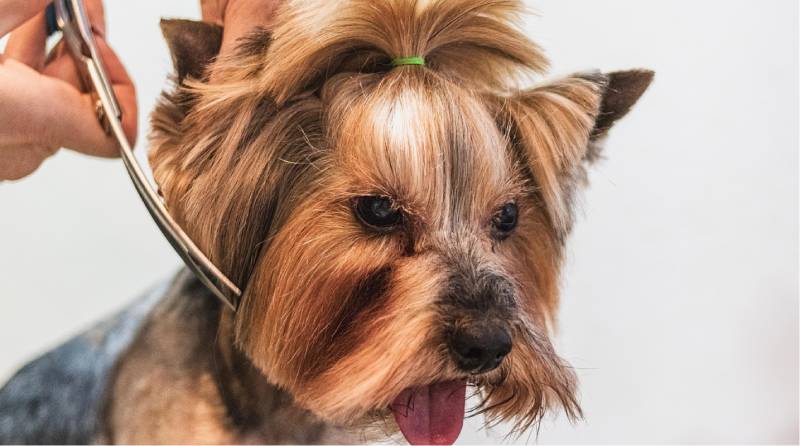If you’ve ever run your hand over a Doberman’s sleek coat, you might think, “Short hair? This must be a low-shed breed.” Then reality hits—tiny bristly hairs on your clothes, in your couch cushions, and mysteriously… in your morning coffee. Dobermans may not blow their coats like a Husky or German Shepherd, but they do shed, and for some owners it can feel like a never-ending battle.
In this guide, we’ll break down exactly how much shedding you can expect from a Doberman Pinscher, why coat texture matters, and what factors can make one Dobie shed more than another. You’ll also learn practical, vet-approved strategies to keep loose hair under control—so you can spend more time enjoying your loyal companion, and less time chasing fur tumbleweeds around the house.

Do Doberman Pinscher Shed A Lot?
Doberman Pinschers do shed, but not excessively compared to many other breeds.
Doberman Pinschers are considered moderate shedders. They have short, sleek coats that shed a small amount year-round, with a slight increase during seasonal changes—usually in spring and fall. Because their fur is short and lies close to the skin, loose hairs are less noticeable and easier to manage.
Why Do Doberman Pinschers Shed?
The amount and pattern of shedding in Dobermans is influenced by several factors:
1. Year-Round Hair Turnover
Unlike double-coated breeds that “blow” their coats seasonally, Dobermans shed lightly but consistently throughout the year. That means you won’t get giant tufts of fur in spring and fall, but you will notice a steady sprinkle of short bristles on floors, clothes, and furniture.
2. Coat Texture Variations
Some Dobermans have coarse hair that sheds less and is easier to clean up. Others have fine, silky hair that comes out more easily and clings stubbornly to fabrics. This is why two Dobermans in the same household can have very different shedding patterns.
3. Health and Nutrition
Skin and coat health play a big role. Issues like hypothyroidism, allergies, or skin infections can increase shedding, as can poor diet lacking essential fatty acids. A balanced, nutrient-rich diet and regular vet check-ups help keep shedding within a normal range.
4. Environment and Stress
Changes in temperature, humidity, or routine can also trigger increased shedding. Moving to a new home, changes in daylight, or even emotional stress can all impact a dog’s coat cycle.
In short, Doberman shedding is completely normal—but understanding what affects it can help you manage it more effectively and spot any unusual changes early.
How to Manage Doberman Shedding?
While you can’t stop a Doberman from shedding altogether, you can keep loose hair under control and maintain a healthier coat with a few simple habits.

1. Brush Regularly
Even short coats benefit from regular brushing. Use a rubber grooming mitt or curry brush 2–3 times a week to remove loose hair before it ends up on your floors and furniture. This also stimulates natural skin oils, keeping the coat shiny.
2. Bathe Strategically
A monthly bath with a gentle, dog-safe shampoo can loosen dead hairs and wash away dander. Avoid overbathing—too much washing can strip natural oils and lead to dryness, which may increase shedding.
3. Support Skin & Coat Health Through Diet
Feed a high-quality diet rich in protein and essential fatty acids (Omega-3 and Omega-6). Supplements like fish oil or salmon oil can help reduce excessive shedding and improve coat texture.
4. Keep Up with Vet Care
Regular check-ups can catch health issues that cause abnormal shedding, such as hypothyroidism or skin allergies. Treating underlying problems often improves coat condition.
5. Maintain a Clean Environment
Short Doberman hairs have a way of working into fabrics and carpets. A robot vacuum, lint rollers, and frequent sweeping can make day-to-day cleanup easier. Choosing furniture fabrics and floor colors that don’t highlight hair can also reduce visual stress.
6. Reduce Stress and Environmental Triggers
Sudden changes in schedule, climate, or living environment can cause a temporary uptick in shedding. Maintaining a consistent routine and comfortable home climate can help minimize fluctuations.
By combining good grooming, nutrition, and health care, you can make Doberman shedding far more manageable—keeping your home cleaner and your dog looking their best.
How to Deal with The Shedding in Your House?
Even with the best grooming routine, some Doberman hair will still find its way into your home. The key is to have a cleaning strategy that keeps you ahead of it.
1. Invest in the Right Vacuum
Short, bristly Doberman hairs can cling stubbornly to floors and carpets. A vacuum with strong suction, a motorized brush head, and a HEPA filter works best. Robot vacuums can be a lifesaver for daily maintenance, especially on hard floors.
2. Use Lint Rollers and Fabric Brushes
Keep lint rollers in high-traffic areas and by the door. They’re quick and effective for clothing, upholstery, and car seats. For heavier hair buildup, a reusable fabric brush or pet hair remover tool can be more cost-effective.
3. Protect Your Furniture
Washable slipcovers, throws, or blankets on sofas and chairs can catch most of the hair and are easy to toss in the laundry. Opt for tightly woven fabrics, which are less likely to trap hair deep in the fibers.
4. Sweep and Mop Frequently
On hardwood or tile, daily sweeping or a quick pass with a microfiber dust mop will prevent hair from accumulating. For deep cleaning, damp mopping can catch fine hairs that brooms leave behind.
5. Create “Dog Zones”
If possible, limit your Doberman’s access to certain rooms—especially bedrooms or areas with high-maintenance flooring. Providing cozy dog beds in these zones encourages them to settle in their own space, reducing overall hair spread.
6. Exercise Your Doberman
Regular exercise isn’t just for burning energy—it also helps maintain healthy skin and coat. A well-exercised Doberman has better circulation, reduced stress, and a more balanced coat-shedding cycle. Daily walks, play sessions, and mental stimulation can indirectly help keep shedding at a manageable level.
Conclusion
Doberman Pinschers do shed. Their short, shiny coats might look easy to care for, but those little hairs have a way of ending up everywhere—on your clothes, in the couch, even in your coffee. With a bit of routine brushing, good nutrition, regular vet visits, and a smart approach to cleaning, it’s totally manageable. Once you know why Dobermans shed and how to stay on top of it, you’ll spend less time sweeping up and more time enjoying the loyalty, smarts, and big personality that make this breed such a joy to live with.
FAQ
Do Dobermans are hypoallergenic?
No, Dobermans are not considered hypoallergenic. They have short, sleek coats that shed moderately year-round and can produce dander, which may trigger allergies. While some individuals with mild allergies may tolerate them better than heavy-shedding breeds, they can still cause allergic reactions. Regular grooming, bathing, and cleaning can help reduce allergens, but there’s no guarantee a Doberman will be allergy-friendly for sensitive individuals.
Are Dobermans high maintenance?
Dobermans can be moderately high maintenance due to their intelligence, energy, and need for physical and mental stimulation. They require daily exercise, consistent training, and socialization to thrive. Their short coat is low-maintenance for grooming, but they can be prone to certain health issues. Without enough attention and activity, they may develop behavioral problems. With proper care, Dobermans are loyal, loving, and well-behaved companions.
Are Dobermans a good house dog?
Yes, Dobermans can be excellent house dogs when trained and socialized properly. They’re intelligent, loyal, and protective, making them great family companions. They thrive on human interaction and need regular exercise and mental stimulation. While affectionate with family, their protective instincts require consistent training. With proper care, they adapt well to home life, offering both companionship and security in a loving, energetic package.


